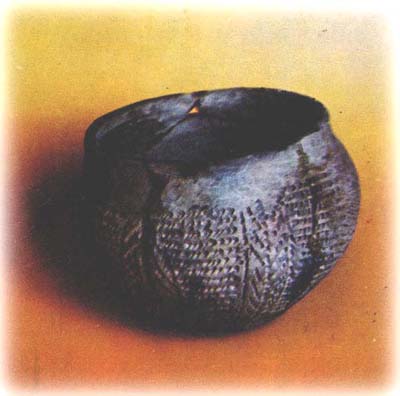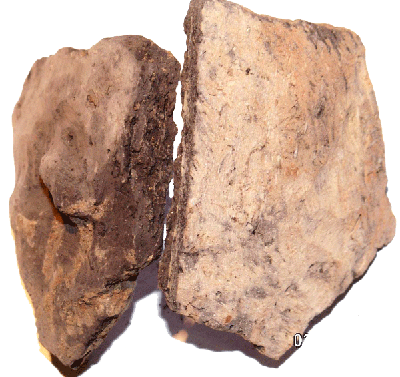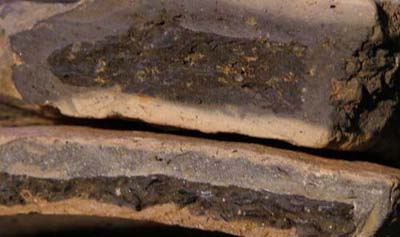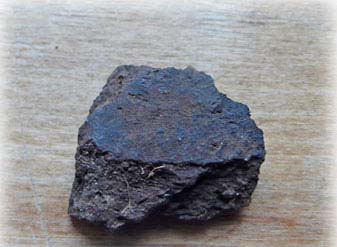
Radiocarbon Dating: Pottery and Ceramic
Introduction.
Pottery and especially pottery sherds most often present at archaeological sites worldwide. They are preserved for long because of physical parameters of their matrix. In some cases they are used for dating sites 'relatively' taking into account their different peculiarities: form, picture and ornament, kind of matrix, kind of inclusion and additives etc. Unfortunately such dating could not be applied for any sample and site. Application of radiocarbon in the case gives a hope for site dating.

Is carbon dating possible for pottery? It depends.
Base.
Different types of ceramic products becoming widely used and distributed in Eastern Europe since the end of VII-VI millennium BC. Manufacture of early pottery was closely associated with the technologies in which except for the clay component for plasticity and strength were used organic additives (grass, straw, river and lake silt and manure). The presence of this type of ceramic creates the preconditions for successful radiocarbon dating of many archaeological Neolithic sites. In these conditions, radiocarbon dating of ceramic fragments is the only reliable way to obtain of radiocarbon dates from a specific cultural phenomenon.
Carbon sources.
As it was reported by [N. Kovalyukh, V. Skripkin, M. Videiko] datable carbon containing in pottery could be different origin: one added into clay during of pottery production (for plasticity and strength), other penetrate into pottery matrix during preparing food or using oil for lighting. Both are transformed into fine coal inside of alumosilicate matrix.
These organic additives in the clay batch were the dominant primary ceramics and reach tens of percent. The carbon content of coal inclusions after annealing ceramics is, in most cases, about 0.6-2% of its total weight. This carbon is relatively well protected from oxidation inside of the aluminum-silicate matrix.
By the way additives into clay could be different origin like vegetables, humus and lake sediments - i.e. they have different age at the moment of introduction into pottery matrix. Such different pottery when radiocarbon is determined requires different interpretation.
Besides to datable Carbon samples contain contamination. Depending to kind of matrix it is possible to separate contamination by removing external part of ceramic body and washing by HCl and HF solution.
When pottery and ceramic could be carbon dated.
As datable carbon concentration in pottery could be at level of 0.5% - 2.0% it is required to concentrate it and transform into counting media. As for AMS method about 50-200 mg of Carbon concentrated and separated. Conventional radiocarbon dating require much more of Carbon. Modern technology described [Skripkin & Kovalyukh, 1998 or here] allows to proceed pottery using of direct pyrolysis technology. According to Skripkin Conventional radiocarbon dating technology requires application of modern [Liquid Scintillation Counting ] and [Teflon vials for radiocarbon dating]. 1.0 % of Carbon in pottery body corresponds to about 1.0 g of benzene prepared for LS counting.
Applicable sample treatment is based on known early developments, see references below.
- Barker, H. (1953) Radiocarbon dating: Large-scale preparation of acetylene from organic material. Nature 172: 631-632.
- Starik, I.E., Arslanov, Kh.A. and Klener, I.R. (1963) Improved chemical procedure of sample treatment for radiocarbon dating by means of scintillation technique. Radiokhimiya 5(2): 198-205.
- Noakes, J.E., Kirn, S.M. and Stipp, J.J. (1965) Chemical and counting advances in liquid scintillation age dating. In Radiocarbon and Tritium Dating: Proceedings of the 6th International Conference on Radiocarbon and Tritium Dating, Washington State University, Pullman, Wash., June 7-11, 1965. Oak Ridge, Tennessee, U.S. Atomic Energy Commission: 650-652.
- Polach, H.A. and Stipp, J.J. (1967) Improved synthesis techniques for methane and benzene radiocarbon dating. International Journal of Applied Radiation and Isotopes 18: 359-364.
- Arslanov, Kh.A. and Tertchny, N.I. (1970) On acetylene synthesis from CO; for radiocarbon dating. In Astrophysical Phenomena and Radiocarbon. Tbilisi University: 55-60.
- Tamers, M.A. (1975) Chemical yield optimization of the benzene synthesis for radiocarbon dating. International Journal of Applied Radiation and Isotopes 26(11): 676-683.
Pottery & ceramic sherds.
The advantage of the modern benzene line used to prepare samples for radiocarbon dating is that it allows the C-14 study of a wide range of samples, including samples that have trace amounts of datable carbon. These can be samples of plant origin high ash content, bottom sediments and archaeological ceramics. The use of direct pyrolysis process allows to collect (concentrate) carbon of sample during processing. The most promising result brings the food archaeological ceramics.
Conventional Radiocarbon Dating of Archaeological Pottery and Ceramic
Archaeological pottery and ceramic require introduction in sample preparation delicate sample's individual approach.
It includes following steps:
- Estimation of Carbon mass in sample: total mass of sample, percentage of Carbon in sample, percentage of possible contamination, possible way of separation of contamination: acid washing, multi-layer sub-samples, combination of above mentioned, etc.,
- Estimation of possible quality of dating results,
- Estimation of individual resources (time, materials) to estimate individual cost of sample,
- Sample pre-treatment,
- Sample milling,
- Carbide production by pyrolysis,
- Acetylene production,
- Preparing benzene,
- Counting of the sample,
- Preparing Report on sample age and real quality of its estimation.
REFERENCES
N. Kovalyukh, V. Skripkin, M. Videiko. Peculiarities Of Radiocarbon Dating Of Ancient Archaeological Pottery. In the Abstracts of The First World Congress "Trypillian Civilization" held in Kyiv, 7-11 October 2005.
G Zaitseva, V. Skripkin, N.Kovaliukh, G Possnert, P Dolukhanov, A.Vybornov. Radiocarbon Dating of Neolithic pottery. Proceedings of the 5th International 14C and Archaeology Symposium, edited by Irka Hajdas et al. RADIOCARBON, Vol 51, Nr 2, 2009, p 795-801
A Vybornov, G Zaitseva, N Kovaliukh, M Kulkova, G Possnert, V. Skripkin. Chronological Problems with Neolithization of the Northern Caspian Sea Area and the Forest-Steppe Povolzhye Region RADIOCARBON. Vol 54, No 3-4 (2012) PP.795-799
Yaroslav V Kuzmin, A J Timothy Jull, G S Burr. Major Patterns in the Neolithic Chronology of East Asia: Issues of the Origin of Pottery, Agriculture, and Civilization RADIOCARBON. Vol 51, No 3 (2009)
Y V Kuzmin. The Origin of Pottery in East Asia and Its Relationship to Environmental Changes in the Late Glacial. RADIOCARBON. Vol 52, No 2 (2010)
R. E. M. Hedgesi, Chen Tiemei and R. A. Housley. Results and methods in the radiocarbon dating of pottery. RADIOCARBON, VOL. 34, No. 3, 1992, P. 906-915
Direct dating of Neolithic pottery: progress and prospects 8th NEOLITHIC SEMINAR The Neolithisation of Eurasia - Perspectives from Pottery Ljubljana 8 - 11 November 2001
Youtube channel: benzene-line.com
Page last saved at: 26/08/2021


